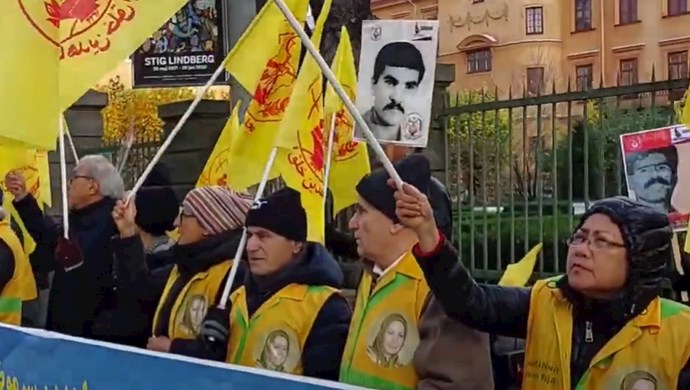Reporting by PMOI/MEK
Sweden, October 26, 2021—On Tuesday, Stockholm’s District Court convened for the thirty-third session of the trial of Hamid Noury, an Iranian prison official charged with torturing inmates in the Gohardasht prison (Karaj) and taking part in the 1988 massacre of thousands of political prisoners. Noury was apprehended by Swedish authorities during a trip to the country. Noury is now standing trial in a court where many of his victims are giving harrowing testimonies of how he and other regime officials brutally tortured prisoners.
During Tuesday’s session, Reza Fallahi, a former political prisoner and a supporter of the People’s Mojahedin Organization of Iran (PMOI/MEK), testified in court. Fallahi has spent ten years in Iran’s prisons and is one of the witnesses of the “1988 massacre,” a brutal period in the summer of 1988 during which the regime carried out the swift and brutal execution of more than 30,000 political prisoners across Iran, mostly MEK members and supporters. The purge was directly ordered by regime supreme leaders Ruhollah Khomeini in an edict that explicitly stated that anyone supporting the MEK is an enemy of God and deserves to be executed.
At the time of the 1988 massacre, Fallahi was in Gohardasht prison. According to his testimony, the regime was preparing for the massacre in advance. “When they brought us to Gohardasht, a new period began which eventually led to the 1988 massacre,” he said. “They gradually deprived us of all facilities and imposed more restrictions, including assemblies, group sports, and objects that we had created ourselves. The quality and quantity of food degraded. They took away all televisions from the wards. It was clear that they were planning something.”
On July 19, when the Iranian regime accepted the ceasefire agreement with Iraq, Fallahi saw a report in one of the state-run newspapers that quoted a judiciary official stating that the status of all prisoners will soon be revised. “He had stressed that the sentences will be reduced and some will be intensified, and some will be pardoned. There was no mention of executions, and given that the regime had accepted the [UN Security Council] Resolution 598, these remarks were alarming,” Fallahi said.
During those days, the regime broadcasted Friday prayer sermons in the prison. “The people who spoke at the Friday prayers were calling for the execution of MEK prisoners,” Fallahi said. “These slogans are usually prepared and organized in advance. We realized that the regime is preparing the grounds for [the executions].”
On July 28, prison guards took away several prisoners from the ward where Fallahi was incarcerated. “After several hours that they came back, Mehran Hoveida and Ahmad Gorji, who were among them, were brutally tortured,” Fallahi said. “They had beaten them with metal bars and the mark was visible on their backs. They were among the first people who were taken for execution and they were hanged on July 30 as the massacre started.”
In his testimony, Fallahi also said, “On July 30 and 31 that the massacre had just started, we saw men and women who were brought into the prison. These people were blindfolded and taken to the ceremony hall. We later realized that they were prisoners who were brought to Gohardasht for execution.”
Fallahi stressed that during the executions, notorious judge Mohammad Moghiseh, who was known as Nasserian in prison, made sure all prison guards participated in the executions.
Fallahi was taken to the “death corridor” where prisoners were lined up to wait for their turn to meet the “death commission.” The “Death Commission” was the group of regime officials who carried out Khomeini’s fatwa. They summoned political prisoners and held minutes-long trials. Any prisoner who did not disavow their support for the MEK was immediately sent to the gallows. One of the key members of the death commission was Ebrahim Raisi, who is now the regime’s president, and Mostafa Pourmohammadi, the former justice minister. The "death hall" was the large room where prisoners were hanged in groups while others were forced to watch them until their turn came. Very few people went into the death hall and came back to tell the story. Those who did have given horrific accounts of how the regime humiliated and tortured prisoners even in the last minutes of their lives.
When the prosecutor asked Fallahi what happened to the prisoners he saw in the death corridor, he said, “I never saw any of those prisoners again. They were all executed during the massacre. I contacted many of the families and they told me that they had been informed that they were executed. They were instructed not to hold any ceremony for their loved ones.”
Fallahi explained that as the executions started, Hamid Noury and Nasserian were very happy and they were distributing sweets among prison authorities. Like other former prisoners who testified in court, Fallahi testified that he saw prison guards carry hanging ropes in wheelbarrows. He also witnessed prison guards quarreling among themselves when they were looting the prisoners’ bodies.





